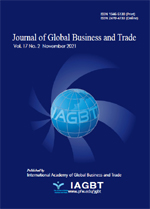Revealed Trade Competitiveness between Korea and Japan. Is It Viable to Deepen Economic Integration?
- The International Academy of Global Business and Trade
- Journal of Global Business and Trade
- Vol. 17, No. 2
-
2021.1167 - 84 (18 pages)
-
DOI : 10.20294/jgbt.2021.17.2.67
- 27

Purpose – This study examines the trade competitiveness and complementarity of the economic structures of Korea and Japan. We focus on the sectors likely to be directly affected if the export control measures introduced by Japan on its exports of semiconductor machinery and raw materials to Korea in July 2019 are prolonged. Design/Methodology/Approach – The analysis applies Balassa’s Revealed Comparative Advantage (RCA), the Normalized Revealed Comparative Advantage (NRCA), the Bilateral Revealed Comparative Advantage (BRCA), the Relative Trade Advantage (RTA), and the Trade Complementarity indices to examine Korea’s and Japan’s trade competitiveness, bilaterally and globally. The empirical analysis focuses on forty-six major traded sectors and five Electronic integrated circuit-related industries, based on two-digit and six-digit data, respectively. Data applied is from the UNComtrade database. Findings – Expectantly, where Korea has bilateral trade competitiveness, Japan has a disadvantage, and vice versa. A sharp decline in the calculated results for sector HS854232 (Electric, integrated circuit sector) of Korea in 2019 in all indices compared to other periods is identified. Additionally, empirical results indicate that the export control measures by Japan have an immediate impact on Korea’s trade competitiveness, especially the Electronic integrated circuits and memory sector. Research Implications – This study provides an impact assessment of the export control measures imposed by Japan on its exports of semiconductor raw materials and machinery to Korea on the trade competitiveness of Korea, focusing on the Electric, integrated circuit sector at six-digit HS product classification. To the best of the authors’ knowledge, this is the first study to empirically analyze the impact of the export control measures by Japan on its exports of semiconductor raw materials on the trade competitiveness of Korea at the six-digit HS product code.
I. Introduction
II. Bilateral Trade Patterns and the Relations of Korea and Japan
III. Literature Review
IV. Methodology and Data
V. Empirical Results
VI. Concluding Remarks
(0)
(0)